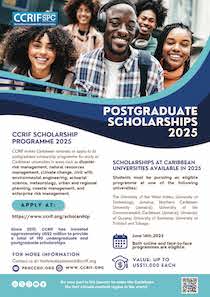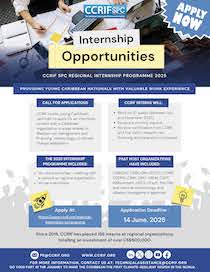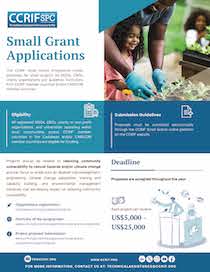Grand Cayman, Cayman Islands, November 9, 2012 – The Caribbean Catastrophe Risk Insurance Facility (CCRIF) and the Seismic Research Centre (SRC) of The University of the West Indies have entered into a partnership to enhance the Accelerometric Network in the Eastern Caribbean and Jamaica in order to strengthen the evaluation and mitigation of seismic risk across the region. In April of this year, the two organisations signed a Memorandum of Understanding and entered into a cooperative agreement to implement this two-year project which will cost ~US$235,000 – with US$120,000 provided by CCRIF and the remainder provided by SRC.
Located at The University of the West Indies (UWI) St Augustine campus in Trinidad & Tobago, the SRC is the leading agency in the Eastern Caribbean for monitoring earthquakes, volcanoes and tsunamis. The SRC is responsible for disseminating information to reduce risk, deaths, injuries, property damage and economic loss due to these hazards. The partnership with CCRIF will take advantage of the Facility’s experience and services in active financial risk management of natural catastrophes in the region. Activities to be undertaken under this partnership will be implemented by the SRC in collaboration with the Earthquake Unit at the UWI Mona campus in Jamaica.
Currently there are more than 50 seismic stations in the entire SRC network. Under this partnership there will be the installation of twelve additional strong motion instruments in seven countries (Grenada, Barbados, Saint Lucia, Dominica, Antigua & Barbuda, St Kitts & Nevis, and Jamaica) to extend the existing accelerometer network in the Caribbean, some components of which are part of regional tsunami surveillance efforts. These new instrument stations will increase regional coverage and focus on “hot spots” in the Eastern Caribbean and Jamaica. Additionally, these strong motion instruments will complement the SRC’s existing weak motion network, which has grown from the first stations installed in the 1950s to its current level, used to gather data to help understand spatial and temporal characteristics of earthquakes. Strong motion data are used to undertake more in-depth analysis to inform earthquake hazard assessments. This analysis can be used to determine areas at risk and to inform disaster preparedness decision making.
This partnership also will focus on building the data and knowledge bases in the region and on disseminating data to professionals in the disaster management, construction and engineering communities throughout the region. A key activity will be the production of an annual catalogue in digital format of the data collected by the network, which will be made available through the SRC website.
Dr Joan Latchman, Acting Director of the SRC, believes that, “This initiative will enable the Seismic Research Centre to improve the level of monitoring and therefore to improve the quality of the advice and information provided to regional governments regarding emergency response, public safety and loss mitigation.”
While hurricanes are a well-known and dangerous threat to the Caribbean, this project is invaluable to the region since these countries are also vulnerable to earthquakes, volcanic eruptions and tsunamis. The Eastern Caribbean is a seismically active area with hundreds of earthquakes occurring in and around the region each year – although not all of these earthquakes are felt. In Jamaica there is a well-known history of destructive earthquakes with about 200 earthquakes located in and around the island per year. No island in the region is completely free from the threat of earthquakes.
Mr Milo Pearson, Executive Chairman of CCRIF, said that this partnership between the SRC and CCRIF fully supports CCRIF’s goal to promote capacity development for natural catastrophe risk management in the region and observed that the project “will build knowledge within The University of the West Indies – and by extension the Caribbean – with respect to seismic risk and vulnerability, thus contributing to reducing the impact of earthquakes.”
About SRC: The Seismic Research Centre of The University of the West Indies (St Augustine campus, Trinidad & Tobago) monitors earthquakes and volcanoes for the English-speaking islands of the Eastern Caribbean. The SRC also jointly manages the Montserrat Volcano Observatory with the Institut de Physique du Globe de Paris. The SRC maintains a volcanic surveillance and warning system in its contributing territories, conducts research on the distribution and frequency of earthquakes in the Eastern Caribbean and provides advice on earthquake and volcano related issues to nine Eastern Caribbean governments.
About CCRIF: CCRIF is a not-for-profit risk pooling facility, owned, operated and registered in the Caribbean for Caribbean governments. It is designed to limit the financial impact of catastrophic hurricanes and earthquakes to Caribbean governments by quickly providing short-term liquidity when a policy is triggered. It is the world’s first regional fund utilising parametric insurance, giving Caribbean governments the unique opportunity to purchase earthquake and hurricane catastrophe coverage with lowest-possible pricing. CCRIF represents a paradigm shift in the way governments treat risk, with Caribbean governments leading the way in pre-disaster planning. CCRIF was developed through funding from the Japanese Government, and was capitalised through contributions to a multi-donor Trust Fund by the Government of Canada, the European Union, the World Bank, the governments of the UK and France, the Caribbean Development Bank and the governments of Ireland and Bermuda, as well as through membership fees paid by participating governments.
For more information, contact pr@ccrif.org (CCRIF) or uwiseismic@uwiseismic.com (SRC) or visit the CCRIF website at www.ccrif.org or the SRC website at www.uwiseismic.com.
English





